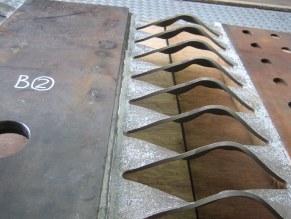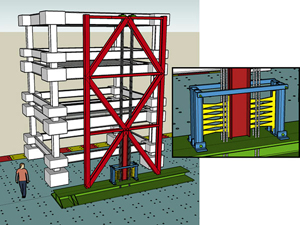Steel “fuses” that distort when a building shakes during an earthquake to dissipate the energy could allow multi-story buildings hold themselves together during even violent earthquakes and then return to standing plumb straight afterwards. The fuses would then be replaced once the aftershocks die down.
The system has been tested in Japan, will not only help a multi-story building hold itself together during a violent earthquake, but also return it to standing up straight on its foundation afterward, true and plumb, with damage confined to a few easily replaceable parts.
Researchers at Stanford University and the University of Illinois in the US designed the system to protect buildings from irreparable structural damage even in earthquakes of magnitude 7 of higher, such as the recent event in Indonesia. The team has successfully tested the system on an enormous “shake table” in Japan.

“This new structural system has the potential to make buildings far more damage resistant and easier to repair,” explains Stanford’s Greg Deierlein, “so people could reoccupy buildings a lot faster after a major earthquake than they can now.”
The steel frames, or fuses, would be situated around the building’s core or along exterior walls and could be made part of the building’s initial design or incorporated into an existing building undergoing a seismic refit. The materials employed are commonly used in the construction industry and can be easily made using standard fabrication methods.
“The idea of this structural system is that we concentrate the damage in replaceable fuses,” Deierlein explains. The fuses are built to flex and distort, which dissipates the vibrational energy of the earthquake. “What is unique about these frames is that, unlike conventional systems, they actually rock off their foundation under large earthquakes,” Deierlein adds.

The fuses support rocking frames in steel “shoes” secured at their base and with steel tendons running down their centre. These tendons are made of high-strength steel cables twisted together, as the earth moves, they flex and then rebound to their normal length, which pulls the building back into proper vertical alignment afterwards.
Deierlein and his colleagues tested the system at the Hyogo Earthquake Engineering Research Center in Miki City, Japan. They used various configurations to find the most resilient setup.
“This is the first time we’ve put this whole system together to see how it would respond dynamically in a building as if it were subjected to an earthquake,” says Deierlein. It performs well under extreme earthquake shaking.” He adds that even simulating earthquakes above 7 left the rocking frame virtually undamaged on the test rig, which had three 100-tonne “storeys”.
Most seismically designed buildings are self-sacrificial, which means the occupants are saved, but the building must be demolished afterwards. The steel fuse system means that the building would also be saved and when the fuses blow they are simply replaced
Professor Gregory Deierlein homepage